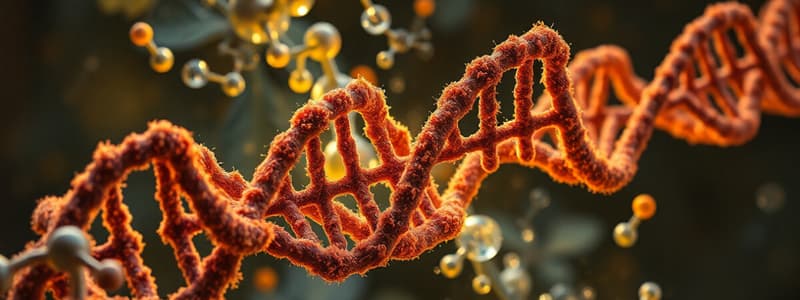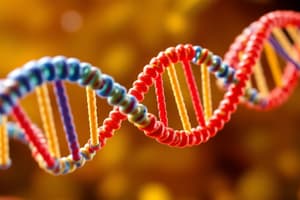Podcast
Questions and Answers
What is the primary function of topoisomerase II during prokaryotic DNA replication?
What is the primary function of topoisomerase II during prokaryotic DNA replication?
- To introduce positive supercoils
- To synthesize new RNA primers
- To untangle interconnected daughter DNA (correct)
- To connect DNA fragments after replication
Which of the following best describes the action of DNA ligase in the replication process?
Which of the following best describes the action of DNA ligase in the replication process?
- It removes RNA primers and replaces them with DNA
- It unwinds the DNA helices
- It synthesizes new DNA strands ahead of the replication fork
- It connects adjacent DNA strands after replication (correct)
How do quinolones and fluoroquinolones affect topoisomerases during DNA replication?
How do quinolones and fluoroquinolones affect topoisomerases during DNA replication?
- They replace DNA ligase in the replication process
- They inhibit the ligase activity of gyrase and topoisomerase IV (correct)
- They promote negative supercoiling
- They enhance the activity of topoisomerases
Which of the following statements about DNA gyrase is accurate?
Which of the following statements about DNA gyrase is accurate?
What enzymatic function is specifically necessary for the initiation of DNA replication?
What enzymatic function is specifically necessary for the initiation of DNA replication?
Which DNA polymerase is responsible for gap filling in eukaryotic DNA replication?
Which DNA polymerase is responsible for gap filling in eukaryotic DNA replication?
In eukaryotic DNA replication, which enzyme is primarily responsible for unwinding the DNA double helix?
In eukaryotic DNA replication, which enzyme is primarily responsible for unwinding the DNA double helix?
What is the role of topoisomerases in eukaryotic DNA replication?
What is the role of topoisomerases in eukaryotic DNA replication?
Which protein complex is responsible for the initiation of replication in eukaryotes?
Which protein complex is responsible for the initiation of replication in eukaryotes?
What enzyme is responsible for the removal of RNA primers during eukaryotic DNA replication?
What enzyme is responsible for the removal of RNA primers during eukaryotic DNA replication?
Which type of DNA polymerase is involved in the priming stage of eukaryotic DNA replication?
Which type of DNA polymerase is involved in the priming stage of eukaryotic DNA replication?
What is the primary role of single-stranded binding proteins during DNA replication?
What is the primary role of single-stranded binding proteins during DNA replication?
Which of the following enzymes is involved in sealing nicks in the DNA during eukaryotic replication?
Which of the following enzymes is involved in sealing nicks in the DNA during eukaryotic replication?
What is the primary role of DNA polymerase III in prokaryotic DNA replication?
What is the primary role of DNA polymerase III in prokaryotic DNA replication?
What direction does DNA polymerase synthesize new DNA strands?
What direction does DNA polymerase synthesize new DNA strands?
Which property of DNA polymerases allows them to remain attached to DNA for extended periods?
Which property of DNA polymerases allows them to remain attached to DNA for extended periods?
What role do exonuclease activities of DNA polymerases play during replication?
What role do exonuclease activities of DNA polymerases play during replication?
What is the significance of the origin of replication (ori) in bacterial DNA replication?
What is the significance of the origin of replication (ori) in bacterial DNA replication?
Which statement about primase activity during DNA replication is true?
Which statement about primase activity during DNA replication is true?
Which of the following roles do single-stranded binding proteins play during DNA replication?
Which of the following roles do single-stranded binding proteins play during DNA replication?
How do topoisomerases facilitate DNA replication?
How do topoisomerases facilitate DNA replication?
What distinguishes DNA polymerases in eukaryotic organisms from those in prokaryotic organisms?
What distinguishes DNA polymerases in eukaryotic organisms from those in prokaryotic organisms?
What is a replisome?
What is a replisome?
what keeps DNA open during replication for prokaryotes and eukaryotes
what keeps DNA open during replication for prokaryotes and eukaryotes
what is the sliding clamp?
what is the sliding clamp?
Flashcards are hidden until you start studying
Study Notes
### Eukaryotic DNA Replication Enzymes
- Initiation: Initiator proteins in prokaryotes are replaced with the Origin Recognition Complex (ORC) in eukaryotes.
- Unwinding: The prokaryotic Helicase is replaced by MCM Helicase in eukaryotes.
- Supercoil Removal: Prokaryotes use Topoisomerase & Gyrase, while eukaryotes use Topoisomerases.
- Priming: The prokaryotic Primase is replaced by DNA polymerase α in eukaryotes.
- Primary DNA Synthesis: The prokaryotic DNA polymerase III is replaced by DNA polymerase δ (or ε) in eukaryotes.
- Primer Removal: In prokaryotes, DNA polymerase I removes primers, while in eukaryotes, RNase H or FEN‐1 performs this function.
- Gap Filling: Prokaryotic DNA polymerase I fills gaps, while in eukaryotes, DNA polymerase δ (or ε) takes on this role.
- Nick Sealing: Both prokaryotes and eukaryotes utilize DNA Ligase to seal gaps in the DNA strands.
Identifying Structures in a DNA Fork
- Direction of fork movement: The fork moves from 5' to 3'.
- Leading strand template: The template strand is oriented 3' to 5'
- Lagging strand template: The template strand is oriented 5' to 3'.
Important Steps in DNA Replication
- Disassembly of replication complexes: This marks the end of the replication process.
- RNA primer removal and replacement with DNA: Ensures a continuous DNA strand is formed.
- DNA ligase connects adjacent strands: Forms a complete and unbroken DNA molecule.
Prokaryotic Termination of DNA Synthesis
- Topoisomerase II untangles interconnected daughter DNA: This resolves any intertwining of the newly replicated DNA strands.
Prokaryotic DNA Gyrase
- A Type II topoisomerase that plays a critical role in DNA replication by neutralizing the positive supercoils generated by Helicase.
- Relaxes DNA by introducing negative supercoils.
- ATP-dependent indicating it requires energy to function.
- Acts like a swivel ahead of the active replication fork: This helps manage tension and prevent the DNA from getting tangled.
Inhibition of Prokaryotic Topoisomerase
- Quinolones & Fluoroquinolones act as inhibitors of Gyrase and Topoisomerase IV.
- These inhibitors block the ligase activity of the enzymes, halting DNA replication.
- These drugs are commonly used as antibiotics and are known for their effectiveness against bacterial infections.
- Eukaryotic topoisomerase inhibitors are structurally different and are given different names.
The Importance of DNA Replication
- Essential for cell division: DNA replication creates a copy of the genome before a cell divides.
Prokaryotic DNA Replication: General Features
- Replication precedes cell division.
- DNA replication creates a complete and faithful copy of the cell's chromosomes.
- The process ensures that each new daughter cell receives a complete copy of the genetic information.
Prokaryotic DNA Polymerase III
- Different types of polymerase exist for tasks including genome replication, repair, and telomere replication.
- The primary polymerase in prokaryotic DNA replication.
- Composed of multiple subunits with specialized functions including proofreading to maintain replication accuracy.
- Displays high processivity: Able to remain attached to DNA for extended stretches without detaching.
- Moves along the DNA template strand, adding complementary bases. This process builds a new DNA strand.
- Catalyzes the addition of nucleotides to the 3' OH end of the growing strand. This ensures that the new strand is synthesized in the 5' to 3' direction.
- Proofreading activity: Identifies and removes incorrectly incorporated nucleotides to ensure high fidelity of replication.
DNA Synthesis by DNA Polymerases
- The synthesised new strand grows in the 5' to 3' direction.
- DNA polymerase requires both a template and a primer to function. The template provides the sequence information, and the primer provides a free 3' OH group for the addition of the first nucleotide.
Prokaryotic DNA Replication: Initiation
- Replication starts at specific sites on the DNA molecule known as ori (origin) of replication.
- These regions contain specific sequences recognized by replication proteins, directing the initiation process.
- Bacteria have a single ori per chromosome, while eukaryotes have multiple origins.
- These regions are where unwinding and separation of the double-stranded DNA (dsDNA) occurs.
- The ori directs the assembly of replication machinery.
- In bacteria, sequences near the ori play a role in distributing replicated chromosomes to daughter cells.
Studying That Suits You
Use AI to generate personalized quizzes and flashcards to suit your learning preferences.




